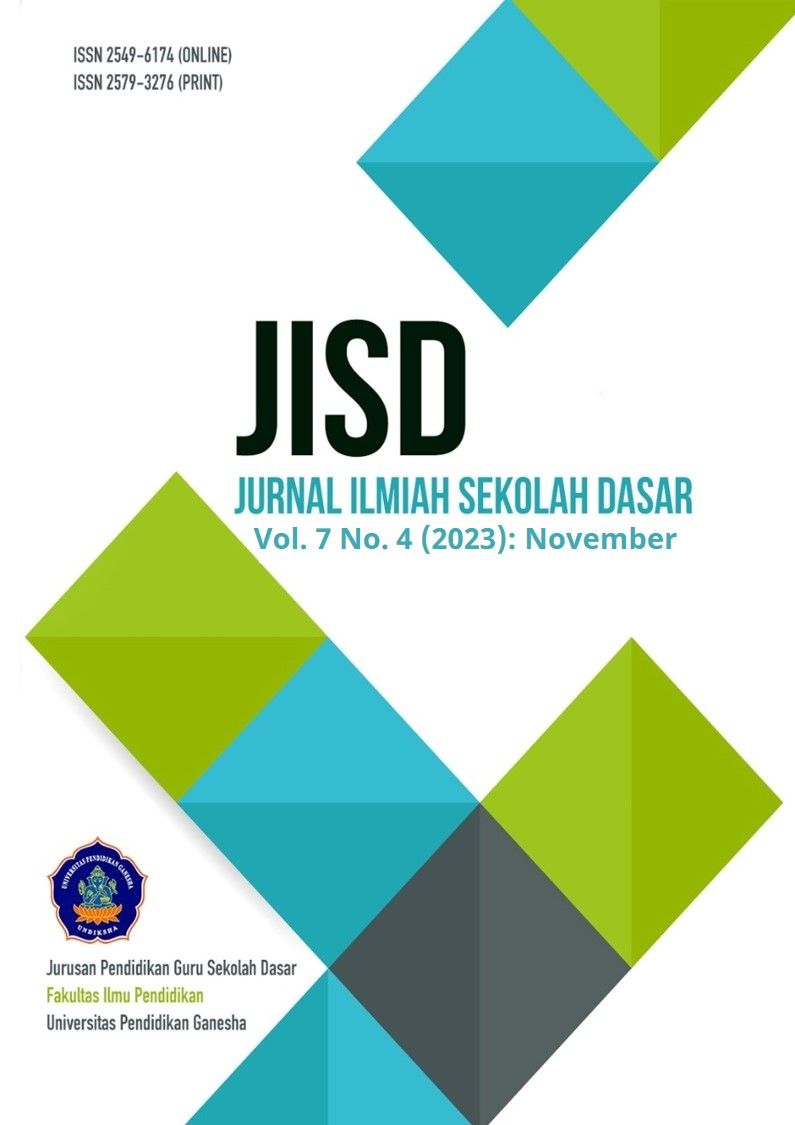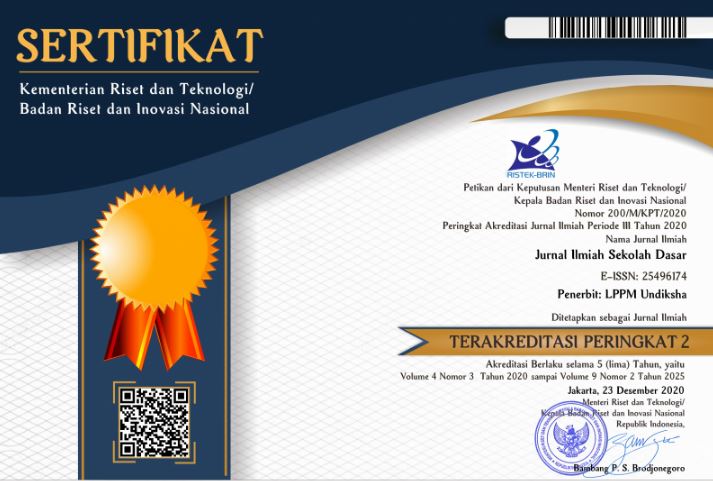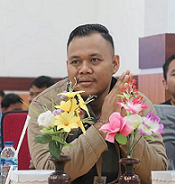SeDiCreSig Method (See, Discuss, Create, Simulate, Generalize) to Improve Analysis Ability of Elementary School Teacher Students
DOI:
https://doi.org/10.23887/jisd.v7i4.59218Keywords:
Mathematics Internship Course, Sedicresig Method, Analytical Skills, Innovative Learning ModelsAbstract
The low ability to analyze learning models will be an obstacle for PGSD (Primary School Teacher Education) students in choosing and implementing learning models that match the learning materials and student characteristics. To improve the analytical skills of PGSD students, the SeDiCreSig method was applied. This study aims to analyze the analytical skills of PGSD students regarding innovative learning models in mathematics in elementary schools (SD) using the SeDiCreSig method. The research method used was quasi-experimental with a pretest-posttest control group design. The population in this study are all 5th-semester PGSD students. The sample used in this study was 70 PGSD students divided into two classes taking the Mathematics Internship course. The data collection techniques used in this study were observation, pretest, and posttest. The data were analyzed by the SPSS 23-assisted t-test. The results of this study indicated an increase in the ability of PGSD students to analyze innovative mathematical learning models after learning using the SeDiCreSig method. The use of the SeDiCreSig method makes it easier for lecturers to direct students in practicing analytical skills and implementing innovative learning models, especially in learning mathematics. The success of learning the SeDiCreSig method must be supported by actual activities that students directly carry out.
References
Alifaruzzahro, Q. (2017). Kemampuan Berpikir Kritis Matematis Siswa Kelas VIII Ditinjau Dari Self Regulated Learning Pada Pembelajaran Model Search, Solve, Create, And Share. Imajiner: Jurnal Matematika Dan Pendidikan Matematika, 4(5), 204. http://journal.upgris.ac.id/index.php/imajiner/article/view/11171.
Alwansyah, Purnomo, E., & Pargito. (2015). Meningkatkan Keterampilan Sosial Siswa Dengan Menggunakan Model Simulasi. Jurnal Studi Sosial, 3(1), 1–13. https://www.neliti.com/publications/41024/meningkatkan-keterampilan-sosial-siswa-dengan-menggunakan-model-simulasi.
Amna Saleem, Huma Kausar, & Farah Deeba. (2021). Social Constructivism: A New Paradigm in Teaching and Learning Environment. Perennial Journal of History, 2(2), 403–421. https://doi.org/10.52700/pjh.v2i2.86. DOI: https://doi.org/10.52700/pjh.v2i2.86
Anggraini, A. (2018). Keefektifan Pembelajaran Elektronik (E-Learning) Sebagai Pengganti Perkuliahan Konvensional Untuk Meningkatkan Kemampuan Analitis Mahasiswa. Jurnal Sosial Humaniora, 9(2), 95. https://doi.org/10.30997/jsh.v9i2.1101. DOI: https://doi.org/10.30997/jsh.v9i2.1101
Ardyansyah, A., & Fitriani, L. (2020). Efektivitas Penerapan Metode Discovery Learning dalam Pembelajaran Imla’. Al-Ta’rib : Jurnal Ilmiah Program Studi Pendidikan Bahasa Arab IAIN Palangka Raya, 8(2), 229–244. https://doi.org/10.23971/altarib.v8i2.2257. DOI: https://doi.org/10.23971/altarib.v8i2.2257
Aristawati, F. A., & Budiyanto, C. (2017). Penerapan Robotika Dalam Pembelajaran STEM:Kajian Pustaka. Prosiding Seminar Nasional UNS Vocational Day, 2, 440–446. https://doi.org/10.20961/uvd.v1i0.15854.
Creswell, J. W., & Creswell, J. D. (2018). Research design qualitative, quantitative, and mixed methods approaches. In SAGE Publication, Incs (5th ed.). SAGE Publications, Inc.
Damaianti, V. S., Abidin, Y., & Rahma, R. (2020). Higher order thinking skills-based reading literacy assessment instrument: An Indonesian context. Indonesian Journal of Applied Linguistics, 10(2). https://doi.org/10.17509/ijal.v10i2.28600. DOI: https://doi.org/10.17509/ijal.v10i2.28600
Dwi Ananda, P., & Eko Atmojo, S. (2022). The Impact of the Discovery Learning Model on Problem-Solving Ability and Scientific Attitude of Elementary School Teacher Education Students. International Journal of Elementary Education, 6(2), 259–267. https://doi.org/10.23887/ijee.v6i2.47684.
Firdian, & Santosa, S. (2022). Implementasi Metode Diskusi Kelompok Pada Mata Kuliah Manejemen Madrasah Di Iain Sas Bangka Belitung. Jurnal Sinektik, 5(1), 60–66. https://doi.org/10.33061/js.v5i1.7489. DOI: https://doi.org/10.33061/js.v5i1.7489
Hanik, N. R. (2020). Implementasi Model Pembelajaran Komparasi yang Diintegrasikan dengan Pendekatan Kolaboratif Ditinjau dari Kemampuan Analisis Mahasiswa Implementation of a Comparative Learning Model which is Integrated with a Collaborative Approach in terms of Student ’ s. Jurnal Komunikasi Pendidikan, 4(2), 114–122. http://journal.univetbantara.ac.id/index.php/komdik/article/download/681/pdf. DOI: https://doi.org/10.32585/jkp.v4i2.681
Haryadi, J. (2022). Pengaruh Metode Diskusi pada Pembelajaran Daring Terhadap Hasil Belajar Mahasiswa Ilmu Kealaman Dasar. Education & Learning, 2(1), 7–11. https://doi.org/10.57251/el.v2i1.230. DOI: https://doi.org/10.57251/el.v2i1.230
Hilbert, S., Bruckmaier, G., Binder, K., Krauss, S., & Bühner, M. (2019). Prediction of elementary mathematics grades by cognitive abilities. European Journal of Psychology of Education, 34(3), 665–683. https://doi.org/10.1007/s10212-018-0394-9. DOI: https://doi.org/10.1007/s10212-018-0394-9
Isnaini, I., Humaira, H., Saoki, M., & Saddam, S. (2020). Pengembangan Inovasi Pembelajaran Pada Mata Kuliah Ilmu Alamiah Dasar Dengan Metode Diskusi Kelompok. IJTIMAIYA: Journal of Social Science Teaching, 4(1), 18. https://doi.org/10.21043/ji.v4i1.7205. DOI: https://doi.org/10.21043/ji.v4i1.7205
Kennedy, I. G., Latham, G., & Jacinto, H. (2015). Education skills for 21st century teachers: Voices from a global online educators’ forum. Springer. DOI: https://doi.org/10.1007/978-3-319-22608-8
Khoiriyah, B. K., & Murni, M. (2021). Peran Teori “Discovery Learning” Jerome Bruner Dalam Pembelajaran Pendidikan Agama Islam. Thawalib | Jurnal Kependidikan Islam, 2(2), 65–78. https://doi.org/10.54150/thawalib.v2i2.20. DOI: https://doi.org/10.54150/thawalib.v2i2.20
Krathwohl, D. R., & Anderson, L. W. (2010). Merlin C. Wittrock and the revision of Bloom’s taxonomy. Educational Psychologist, 45(1), 64–65. https://doi.org/10.1080/00461520903433562. DOI: https://doi.org/10.1080/00461520903433562
Lowrie, T., Logan, T., & Hegarty, M. (2019). The Influence of Spatial Visualization Training on Students’ Spatial Reasoning and Mathematics Performance. Journal of Cognition and Development, 20(5), 729–751. https://doi.org/10.1080/15248372.2019.1653298. DOI: https://doi.org/10.1080/15248372.2019.1653298
Masfingatin, T., & Suprapto, E. (2020). Student’s statistical literacy skills based on the reflective and impulsive cognitive styles. Al-Jabar : Jurnal Pendidikan Matematika, 11(2), 273–286. https://doi.org/10.24042/ajpm.v11i2.6902. DOI: https://doi.org/10.24042/ajpm.v11i2.6902
Moma, L. (2017). Pengembangan Kemampuan Berpikir Kreatif Dan Pemecahan Masalah Matematis Mahasiswa Melalui Metode Diskusi. Jurnal Cakrawala Pendidikan, 36(1), 130–139. https://doi.org/10.21831/cp.v36i1.10402. DOI: https://doi.org/10.21831/cp.v36i1.10402
Nurrohmi, Y., Utaya, S., & Utomo, D. H. (2017). Pengaruh Model Pembelajaran Discovery Learning Terhadap Kemampuan Berpikir Kritis Mahasiswa. Jurnal Pendidikan: Teori, Penelitian, Dan Pengembangan, 2(10), 1308–1314. http://journal.um.ac.id/index.php/jptpp/article/view/10062.
Politsinsky, E., Demenkova, L., & Medvedevа, O. (2015). Ways of Students Training Aimed at Analytical Skills Development while Solving Learning Tasks. Procedia - Social and Behavioral Sciences, 206(November), 383–387. https://doi.org/10.1016/j.sbspro.2015.10.070. DOI: https://doi.org/10.1016/j.sbspro.2015.10.070
Purba, R. (2018). Improving the Achievement on Writing Narrative Text through Discussion Starter Story Technique. Advances in Language and Literary Studies, 9(1), 27. https://doi.org/10.7575/aiac.alls.v.9n.1p.27. DOI: https://doi.org/10.7575/aiac.alls.v.9n.1p.27
Purwaningsih, E., Wahyuni, T., Sari, A. M., Yuliati, L., Suwasono, P., Kurniawan, B. R., & Zahiri, M. A. (2020). Improving students’ critical thinking skills in senior high school through STEM-integrated modeling instruction. The 3rd International Conference on Mathematics and Sciences Education (ICoMSE) 2019, 2215(April). https://doi.org/10.1063/5.0000776. DOI: https://doi.org/10.1063/5.0000776
Putu Dessy Fridayanthi. (2021). Penerapan Model Pembelajaran Discovery Learning Dalam Meningkatkan Hasil Belajar Kepewaraan Mahasiswa Pendidikan Bahasa Indonesia Dengan Pembelajaran Daring. 22(2), 449–458. https://doi.org/10.5281/zenodo.5550359.
Rabbani, S., Ruqoyyah, S., & Murni, S. (2019). Development of basic school mathematic teaching materials to improve the analysis ability of primary teacher education students on innovative learning models. Journal of Physics: Conference Series, 1315(1). https://doi.org/10.1088/1742-6596/1315/1/012011. DOI: https://doi.org/10.1088/1742-6596/1315/1/012011
Rahayu, A. D., & Haq, M. S. (2021). Sarana dan Prasarana dalam Mendukung Pembelajaran Daring pada Masa Pandemi Covid-19. Jurnal Inspirasi Manajemen Pendidikan, 09(1), 186–199. https://ejournal.unesa.ac.id/index.php/inspirasi-manajemen-pendidikan/article/view/38623.
Ramirez, G., Hooper, S. Y., Kersting, N. B., Ferguson, R., & Yeager, D. (2018). Teacher Math Anxiety Relates to Adolescent Students’ Math Achievement. AERA Open, 4(1), 1–13. https://doi.org/10.1177/2332858418756052. DOI: https://doi.org/10.1177/2332858418756052
Rizaldi, D. R., Jufri, A. W., & Jamaluddin, J. (2020). PhET: Simulasi Interaktif Dalam Proses Pembelajaran Fisika. Jurnal Ilmiah Profesi Pendidikan, 5(1), 10–14. https://doi.org/10.29303/jipp.v5i1.103. DOI: https://doi.org/10.29303/jipp.v5i1.103
Salam, I., Haryanto, H., Kurniawati, W., & Izhar, G. (2022). The Effect of Kahoot on Learning Performance of Prospective Elementary School Teacher in Indonesia. Jurnal Pendidikan Progresif, 12(3), 1947–1059. https://doi.org/10.23960/jpp.v12.i3.202205/. DOI: https://doi.org/10.23960/jpp.v12.i3.202205/
Syafi’i, A., Marfiyanto, T., & Rodiyah, S. K. (2018). Studi Tentang Prestasi Belajar Siswa Dalam Berbagai Aspek Dan Faktor Yang Mempengaruhi. Jurnal Komunikasi Pendidikan, 2(2), 115. https://doi.org/10.32585/jkp.v2i2.114. DOI: https://doi.org/10.32585/jkp.v2i2.114
Tyminski, A. M., Simpson, A. J., Land, T. J., Drake, C., & Dede, E. (2021). Prospective elementary mathematics teachers’ noticing of childrens’ mathematics: a focus on extending moves. Journal of Mathematics Teacher Education, 24(6), 533–561. https://doi.org/10.1007/s10857-020-09472-2. DOI: https://doi.org/10.1007/s10857-020-09472-2
Unaenah, E., Hidyah, A., Aditya, A. M., Yolawati, N. N., Maghfiroh, N., Dewanti, R. R., Safitri, T., & Tangerang, U. M. (2020). Teori Brunner pada konsep bangun datar sekolah dasar. Jurnal Pendidikan Dan Ilmu Sosial, 2(2), 327–349. https://ejournal.stitpn.ac.id/index.php/nusantara/article/view/840.
Wahyudhi, A. S. B. S. E. (2020). Kemampuan Motorik Kasar Anak Usia Dini Di Kota Palu. 5(1). https://doi.org/10.32832/educate.v5i1.2020.
Watipah, Y. (2020). Peningkatan Proses Pembelajaran Tematik Terpadu dengan Menggunakan Model Discovery Learning di Kelas IV Sekolah Dasar. Journal on Teacher Education, 1(1), 12–23. https://doi.org/10.31004/jote.v1i1.501. DOI: https://doi.org/10.31004/jote.v1i1.501
Yusuf, M., Subagya, M., I., & Budiarto, M. K. (2022). Implementation of PBL and IBL Models Assisted by Video Media to Improve Critical Thinking Skills. Jurnal Ilmiah Sekolah Dasar, 6(3), 375–384. https://doi.org/10.23887/jisd.v6i3.47949. DOI: https://doi.org/10.23887/jisd.v6i3.47949
Yuwono, T., Ningrum, A. D. I., & Susilo, D. A. (2021). Pengembangan Media Pembelajaran Pop Up Book Berbasis Discovery Learning Membuktikan Luas Dan Keliling Lingkaran. AKSIOMA: Jurnal Program Studi Pendidikan Matematika, 10(2), 479. https://doi.org/10.24127/ajpm.v10i2.3091. DOI: https://doi.org/10.24127/ajpm.v10i2.3091
Downloads
Published
How to Cite
Issue
Section
License
Copyright (c) 2023 Ryan Dwi Puspita, Silvya Rabbani

This work is licensed under a Creative Commons Attribution-ShareAlike 4.0 International License.
Authors who publish with the Journal Ilmiah Sekolah Dasar agree to the following terms:
- Authors retain copyright and grant the journal the right of first publication with the work simultaneously licensed under a Creative Commons Attribution License (CC BY-SA 4.0) that allows others to share the work with an acknowledgment of the work's authorship and initial publication in this journal.
- Authors are able to enter into separate, additional contractual arrangements for the non-exclusive distribution of the journal's published version of the work (e.g., post it to an institutional repository or publish it in a book), with an acknowledgment of its initial publication in this journal.
- Authors are permitted and encouraged to post their work online (e.g., in institutional repositories or on their website) prior to and during the submission process, as it can lead to productive exchanges, as well as earlier and greater citation of published work. (See The Effect of Open Access)










